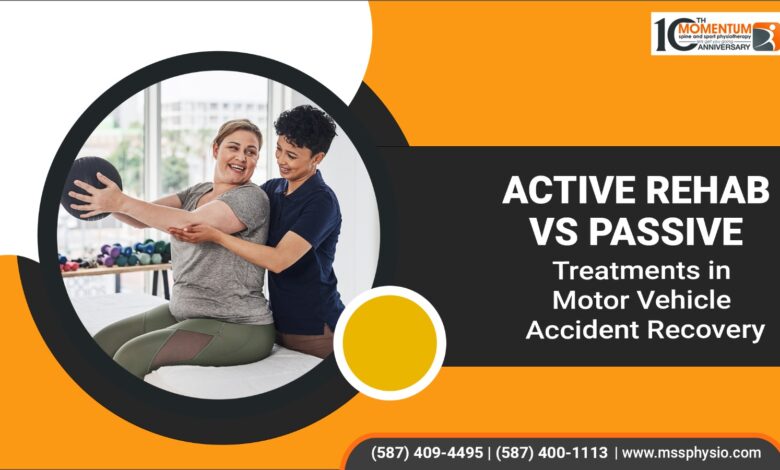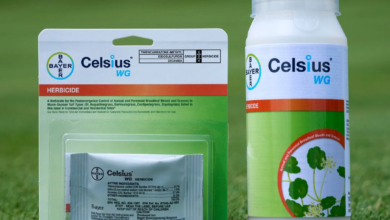Active Rehab vs Passive Treatments in Motor Vehicle Accident Recovery

Recovery from a motor vehicle accident is seldom a simple process. Due to the enormous amount of impact the body experiences, chronic pain and mobility problems that impede day-to-day functioning are frequently the result. Selecting the proper Motor Vehicle Accident Physiotherapy in Edmonton is vital to successful recovery. Rebuilding strength, mobility, and confidence by active therapy and focused passive treatment is included in an overall rehabilitation program that can ensure long-term recovery.
Active vs. Passive Treatments: What’s the Difference?
Active treatments require the patient’s active participation, such as exercise or functional movement training. Passive treatments, like manual therapy or medication, are applied by a healthcare provider without the patient actively performing the movement.
Active Rehabilitation—A Hands-On Approach to Healing
Active rehabilitation enables individuals to take control of their recovery. Systematic movement-based therapies restore function and enhance strength by stimulating muscles, joints, and the nervous system.
- Supervised exercises: Assisted movements, such as bridges for lower back strength or shoulder retractions for posture, aid in focusing on specific injuries and enhancing coordination.
- Strength training: Squats for knee stability and resistance band exercises for shoulder support increase muscle tone and joint protection.
- Mobility exercises: Cat-cow stretches to promote spinal flexibility and ankle circles to enhance joint mobility, decrease stiffness, and enhance range of motion.
- Cardiovascular conditioning: Exercises that improve endurance and general fitness, like stationary cycling and fast walking, make everyday tasks less difficult after an injury.
- Balance and proprioception training: BOSU ball training and single-leg stands enhance body awareness and stability, lessening fall hazards and avoiding reinjury.
Passive Treatments—A Supportive Start to Recovery
Passive therapies give relief from initial pain and are recommended when movement is limited due to pain. They require no active effort but ease pain and inflammation, preparing the body for rehabilitation.
- Heat therapy: Applies warmth to relax muscles, enhance circulation, and relieve stiffness.
- Cold therapy: Aids in the reduction of swelling and numbing acute pain after an injury.
- Ultrasound therapy: Transmits sound waves deep into tissues to alleviate inflammation and encourage healing.
- Electrical stimulation: Uses gentle electrical currents to control nerve function, alleviate pain, and cause muscle contraction.
- Massage therapy: Eases tension, enhances circulation, and aids general relaxation.
- Dry needling: Alleviates muscle tension and trigger points.
- Taping or Bracing: Provides support, enhances stability, and aids injury prevention and recovery.
Finding the Right Balance for Recovery
Passive therapy serves to reduce pain in the initial phase; it cannot serve as a substitute for active rehabilitation. Motor Vehicle Accident Physiotherapy in Edmonton is based on a systematic return-to-movement regime, which is vital to complete recuperation. Professional treatment enables this change to be made at the best possible moment, promoting healing and avoiding long-term complications.
Why Active Rehabilitation is the Gold Standard in Recovery
Long-Term Benefits Over Short-Term Relief
Unlike passive therapy, active rehab targets the root cause of pain, improving movement, preventing stiffness, and promoting lasting recovery. Relying solely on passive treatments may lead to dependence, while active therapy builds resilience against future injuries.
Strengthening the Body for Future Resilience
Active rehabilitation is crucial in the prevention of re-injury. It addresses several critical areas:
- Muscle strengthening: This assists in enhancing joint support and stability.
- Balance exercises: These are necessary for reducing the risk of falls or other injuries.
- Flexibility training: It decreases stiffness and increases mobility.
Engaging the Mind-Body Connection
Healing from an accident injury is not just physical—it’s mental as well. Active rehab instills confidence in motion, allowing the body to break the fear cycle of reinjury (kinesiophobia). Building trust back with the body is a pivotal part of overall healing.
Physiotherapy Techniques for Motor Vehicle Accident Recovery
Rehabilitation following a motor vehicle accident (MVA) tends to involve a combination of physiotherapy procedures to relieve pain, mobility limitation, and functional impairment. The rehabilitation protocol incorporates the following:
Manual Therapy for Pain and Mobility
Hands-on therapies restore motion and decrease pain through
- Joint mobilization: Relieves stiffness and restores range of motion.
- Soft tissue release: Releases tension in the muscles and enhances circulation.
- Myofascial release therapy: Decreases adhesions and scar tissue formation.
Therapeutic Exercises for Strength and Flexibility
Specific exercises rehabilitate strength, enhance function, and guard against future injury:
- Resistance training: Tightens compromised muscles after MVA.
- Core stabilization: Improves posture and spinal support.
- Postural correction exercises: Reduce stress on healing structures.
- Range of motion exercises: Restore injured joints’ flexibility.
Neuromuscular Re-Education for Coordination
Accidents may lead to movement dysfunction, which can be treated by:
- Coordination exercises: Recreate balance and spatial orientation.
- Motor control training: This makes movements more efficient and stable.
- Gait retraining: This reestablishes proper walking patterns following leg or spine injury.
Vestibular Rehabilitation for Dizziness and Whiplash Recovery
MVAs may cause dizziness, vertigo, or whiplash-related disorders. The following specific treatments are involved:
- Vestibular exercises: Minimize dizziness and enhance balance.
- Cervical spine stabilization: Relaxes neck pain and tension.
Choosing the Right Physiotherapy Clinic for Recovery
Choosing a physiotherapy clinic for recovery requires careful consideration of the therapists’ qualifications and experience. Evaluating the clinic’s treatment methods and success rates with similar conditions helps ensure the highest quality of care.
Personalized Care Plans for Effective Recovery
Each injury is different, requiring a tailored approach to rehabilitation. A well-organized physiotherapy clinic offers:
- Personalized recovery programs that are specific to the severity and nature of the injury.
- A stepwise progression from passive treatment to active rehabilitation.
- Ongoing assessment and adjustments to optimize progress.
- Patient education on movement, posture, and self-care.
- Focused assistance from experienced physiotherapists during rehabilitation.
Take Control of The Recovery Journey
Prioritizing active rehabilitation is the key to a full and lasting recovery. Movement-based therapy strengthens the body, reduces pain, and restores confidence after an accident.
Momentum Spine and Sports Physiotherapy Clinic provides a patient-centered approach to healing, ensuring that individuals receive comprehensive care. With Motor Vehicle Accident Physiotherapy in Edmonton, injury recovery is structured, practical, and geared toward long-term wellness. Book a consultation today to start the journey toward better mobility and well-being.
Keywords: Motor Vehicle Accident Physiotherapy in Edmonton, Active rehabilitation, Passive treatments, Motor Vehicle Accident Recovery, accident injury, Whiplash, Strength Training, Postural correction, Vestibular Rehabilitation, Balance and proprioception training, neck pain



